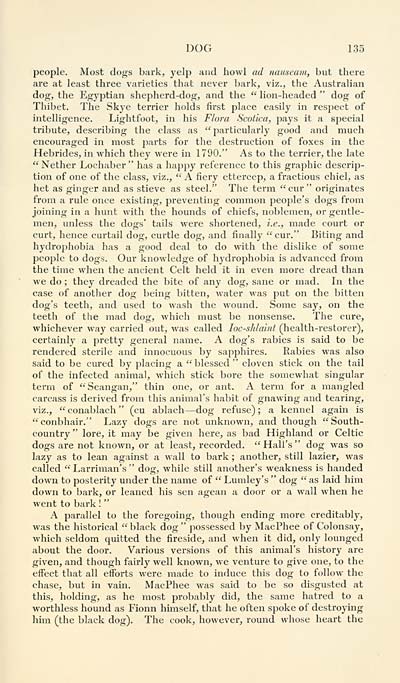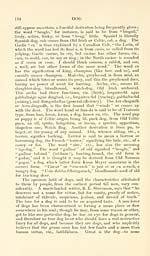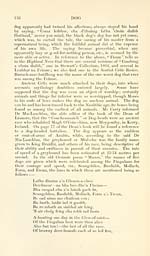Download files
Complete book:
Individual page:
Thumbnail gallery: Grid view | List view

DOG 135
people. Most dogs bark, yelp and howl ad nauseam, but there
are at least three varieties that never bark, viz., the Australian
dog, the Egyptian shepherd-dog, and the " lion-headed " dog of
Thibet. The Skye terrier holds first place easily in respect of
intelligence. Lightfoot, in his Flora Scotica, pays it a special
tribute, describing the class as "particularly good and much
encouraged in most parts for the destruction of foxes in the
Hebrides, in which they were in 1790." As to the terrier, the late
" Nether Lochaber " has a happy reference to this graphic descrip-
tion of one of the class, viz., " A fiery ettercep, a fractious chiel, as
het as ginger and as stieve as steel." The term "cur" originates
from a rule once existing, preventing common people's dogs from
joining in a hunt with the hounds of chiefs, noblemen, or gentle-
men, unless the dogs' tails were shortened, i.e., made court or
curt, hence curtail dog, curtle dog, and finally "cur." Biting and
hydrophobia has a good deal to do with the dislike of some
people to dogs. Our knowledge of hydrophobia is advanced from
the time when the ancient Celt held it in even more dread than
we do ; they dreaded the bite of any dog, sane or mad. In the
case of another dog being bitten, water was put on the bitten
dog's teeth, and used to wash the wound. Some say, on the
teeth of tlie mad dog, which must be nonsense. The cure,
whichever way carried out, was called loc-slila'mt (health-restorer),
certainly a pretty general name. A dog's rabies is said to be
rendered sterile and innocuous by sapphires. Rabies was also
said to be cured by placing a "blessed" cloven stick on the tail
of the infected animal, which stick bore the somewhat singular
term of "Seangan," thin one, or ant. A term for a mangled
carcass is derived from this animal's habit of gnawing and tearing,
viz., "conablach" (cu ablach — dog refuse); a kennel again is
"conbhair." Lazy dogs are not unknown, and though "South-
country " lore, it may be given here, as bad Highland or Celtic
dogs are not known, or at least, recorded. " Hall's " dog was so
lazy as to lean against a wall to bark ; another, still lazier, was
called "Larriman's" dog, while still another's weakness is handed
down to posterity under the name of " Lumley's " dog " as laid him
down to bark, or leaned his sen agean a door or a wall when he
went to bark ! "
A parallel to the foregoing, though ending more creditably,
was the histoi'ical "black dog" possessed by MacPhee of Colonsay,
which seldom quitted the fireside, and when it did, only lounged
about the door. Various versions of this animal's history are
given, and though fairly well known, we venture to give one, to the
effect that all efforts were made to induce this dog to follow the
chase, but in vain. MacPhee was said to be so disgusted at
this, holding, as he most probably did, the same hatred to a
worthless hound as Fionn himself, that he often spoke of destroying
him (the black dog). The cook, however, round whose heart the
people. Most dogs bark, yelp and howl ad nauseam, but there
are at least three varieties that never bark, viz., the Australian
dog, the Egyptian shepherd-dog, and the " lion-headed " dog of
Thibet. The Skye terrier holds first place easily in respect of
intelligence. Lightfoot, in his Flora Scotica, pays it a special
tribute, describing the class as "particularly good and much
encouraged in most parts for the destruction of foxes in the
Hebrides, in which they were in 1790." As to the terrier, the late
" Nether Lochaber " has a happy reference to this graphic descrip-
tion of one of the class, viz., " A fiery ettercep, a fractious chiel, as
het as ginger and as stieve as steel." The term "cur" originates
from a rule once existing, preventing common people's dogs from
joining in a hunt with the hounds of chiefs, noblemen, or gentle-
men, unless the dogs' tails were shortened, i.e., made court or
curt, hence curtail dog, curtle dog, and finally "cur." Biting and
hydrophobia has a good deal to do with the dislike of some
people to dogs. Our knowledge of hydrophobia is advanced from
the time when the ancient Celt held it in even more dread than
we do ; they dreaded the bite of any dog, sane or mad. In the
case of another dog being bitten, water was put on the bitten
dog's teeth, and used to wash the wound. Some say, on the
teeth of tlie mad dog, which must be nonsense. The cure,
whichever way carried out, was called loc-slila'mt (health-restorer),
certainly a pretty general name. A dog's rabies is said to be
rendered sterile and innocuous by sapphires. Rabies was also
said to be cured by placing a "blessed" cloven stick on the tail
of the infected animal, which stick bore the somewhat singular
term of "Seangan," thin one, or ant. A term for a mangled
carcass is derived from this animal's habit of gnawing and tearing,
viz., "conablach" (cu ablach — dog refuse); a kennel again is
"conbhair." Lazy dogs are not unknown, and though "South-
country " lore, it may be given here, as bad Highland or Celtic
dogs are not known, or at least, recorded. " Hall's " dog was so
lazy as to lean against a wall to bark ; another, still lazier, was
called "Larriman's" dog, while still another's weakness is handed
down to posterity under the name of " Lumley's " dog " as laid him
down to bark, or leaned his sen agean a door or a wall when he
went to bark ! "
A parallel to the foregoing, though ending more creditably,
was the histoi'ical "black dog" possessed by MacPhee of Colonsay,
which seldom quitted the fireside, and when it did, only lounged
about the door. Various versions of this animal's history are
given, and though fairly well known, we venture to give one, to the
effect that all efforts were made to induce this dog to follow the
chase, but in vain. MacPhee was said to be so disgusted at
this, holding, as he most probably did, the same hatred to a
worthless hound as Fionn himself, that he often spoke of destroying
him (the black dog). The cook, however, round whose heart the
Set display mode to: Large image | Transcription
Images and transcriptions on this page, including medium image downloads, may be used under the Creative Commons Attribution 4.0 International Licence unless otherwise stated. ![]()
| Early Gaelic Book Collections > Blair Collection > Gaelic names of beasts (mammalia), birds, fishes, insects, reptiles, etc > (161) |
|---|
| Permanent URL | https://digital.nls.uk/79331179 |
|---|
| Description | A selection of books from a collection of more than 500 titles, mostly on religious and literary topics. Also includes some material dealing with other Celtic languages and societies. Collection created towards the end of the 19th century by Lady Evelyn Stewart Murray. |
|---|
| Description | Selected items from five 'Special and Named Printed Collections'. Includes books in Gaelic and other Celtic languages, works about the Gaels, their languages, literature, culture and history. |
|---|

